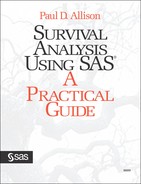Approaches to Survival Analysis
One of the confusing things about survival analysis is that there are so many different methods: life tables, Kaplan-Meier estimators, exponential regression, log-normal regression, proportional hazards regression, competing risks models, and discrete-time methods, to name only a few. Sometimes these methods are complementary. Life tables have a very different purpose than regression models, for example, and discrete-time methods are designed for a different kind of data than continuous-time methods. On the other hand, it frequently happens that two or more methods may seem attractive for a given application, and the researcher may be hard pressed to find a good reason for choosing one over another. How do you choose between a log-normal regression model (estimated with the LIFEREG procedure) and a proportional hazards model (estimated with the PHREG procedure)? Even in the case of discrete-time versus continuous-time methods, there is often considerable uncertainty as to whether time is best treated as continuous or discrete. One of the aims of this book is to help you make intelligent decisions about which method is most suitable for your particular application. SAS/STAT software contains six procedures that can be used for survival analysis. Here’s an overview of what they do:
| LIFETEST | is primarily designed for univariate analysis of the timing of events. It produces life tables and graphs of survival curves (also called survivor functions). Using several methods, this procedure tests whether survival curves are the same in two or more groups. PROC LIFETEST also tests for associations between event times and time-constant covariates, but it does not produce estimates of parameters. |
| LIFEREG | estimates regression models with censored, continuous-time data under several alternative distributional assumptions. PROC LIFEREG allows for several varieties of censoring, but it does not allow for time-dependent covariates. |
| PHREG | uses Cox’s partial likelihood method to estimate regression models with censored data. The model is somewhat less restrictive than the models in PROC LIFEREG, and the estimation method allows for time-dependent covariates. PROC PHREG handles both continuous-time and discrete-time data. |
| LOGISTIC AND PROBIT | are designed for general problems in categorical data analysis, but they are effective and flexible in estimating survival models for discrete-time data with time-dependent covariates. |
| GENMOD | estimates the same discrete-time survival models as LOGISTIC and PROBIT. The procedure is also good for estimating the piecewise exponential model (described in Chapter 4). |
Although not discussed in official documentation, all of these procedures can be used to estimate competing risks models that allow for multiple kinds of events, as described in Chapter 6, “Competing Risks.” Only PROC PHREG has special capabilities for handling repeated events like arrests or hospitalizations. See Chapter 8 for more details.
